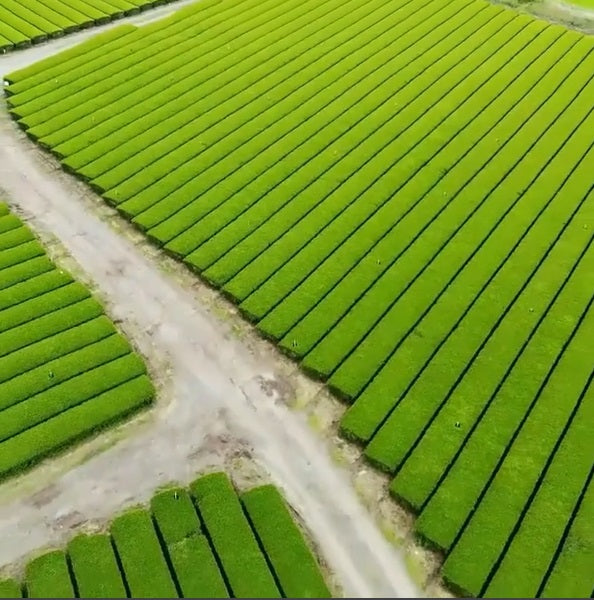Pluck Points

Matcha: A Labour of Love.
Not all matcha is created equal.
We are proud to share the journey of our Premium Ceremonial Matcha - the freshest and healthiest matcha available - directly sourced from Kagoshima Japan.
Origin Notes
While Kagoshima is a younger, lesser known tea region in Japan, the tea makers that we work with here have applied key lessons learned over generations in older tea growing regions, and have been created a thriving, youthful, and innovative organic tea farming community.
It's interesting to note that many matcha makers in the traditional matcha producing region of Uji are now grinding tea leaves grown in Kagoshima for their matcha. There are a couple of reasons for this - first, there isn't enough tea growing in Uji to support consumer demand, and secondly, many teas grown in that part of Japan do not comply to export standards due to the widespread use of pesticides and herbicides.

Dried grasses keep weeds at bay for these young plants in Kagoshima's organic farming community.

Fresh compost is added between the rows for natural nourishment.
--
How Matcha is Made
Tea plants are covered with woven blankets for weeks prior to harvesting, in order to concentrate the chlorophyll in the leaves. These blankets block most (but not all) sunlight, resulting in a brilliant green final product.
The tea leaves that go into our matcha have been covered for an average of 28 days. Farmers visit the fields regularly to check on the progress of the leaf colour, and depending on the weather, those covers stay put until the leaf colour is perfect.

Checking the colour of covered tea leaves.
This covering process is key to the matcha making process, but is stressful to the plant and therefore weakens it. So, many farms apply pesticides, herbicides, and fertilizers liberally to maintain vigorous growth. This is why we source our matcha from organically certified, pesticide - free sources.
Our matcha is tested regularly in Canada by Eurofins (an independent lab) to ensure full compliance with organic standards, and to ensure any pesticides or herbicides are not detected.
Once the leaves are harvested from the fields, they are washed, and steamed lightly.

The leaves are then dried, and fed through a machine that de-stems the leaves. These stems are blown away from the lighter leaf material, (it's magic to see!) and saved for making Houjicha or 'twig tea'.

Tea stems, saved and ready to be roasted for Houjicha or 'twig tea'.
The result is the base tea material for matcha, called 'tencha'. Tencha is often stored in freezers ( set at -26C!) before it is ground into matcha to keep it fresh. When we place an order, the tencha is taken out of the freezer, allowed to come up to room temperature slowly (to prevent condensation) and ground fresh to order, just for us.
--
What Does 'Ceremonial Matcha' Mean, Anyway?
It is a myth that there is an official grading system in place for matcha. In fact, there probably should be. There is certainly a wide range in quality, and labels are murky at best.
The traditional matcha ceremony is a very important part of the tea culture of Japan, and is a fully immersive experience. From the design on the matcha bowls, to the ritual, to the art on the wall, to the floral arrangement in the room, to the kimono and sweets that the host has selected for the season, no detail is overlooked.
A matcha ceremony host will always want to offer the very best matcha they can find to their guests. Usually that is a matcha made from first flush tencha leaves (perhaps with some summer harvest tencha blended in for balance) and it is likely a smooth, umami - rich flavour experience with a deep green colour. It was likely stone - ground slowly, to preserve flavour and quality. It may or may not be organic (likely not), and it might have been produced anywhere in Japan. (Most commonly in Uji, but see note above re: origin)
'Ceremonial Matcha' has become a powerful marketing tool for tea sellers outside of Japan. It can be confusing for consumers, as in our experience, some matcha on retail shelves that would be considered 'mid - grade' in Japan are labelled in this way. The easiest way to boil it down is to qualify 'Ceremonial' as:
- Matcha of Japanese origin (many matchas on the market are produced in China, for instance)
- Spring harvest, or a combination of spring + summer harvest (not fall)
- Smooth flavour, deep green, minimally bitter
- Ground from properly finished tencha - not other teas such as sencha
- 'Suitable for serving guests' (which is of course highly subjective)
Our Premium Ceremonial Matcha ticks all of these boxes, and is also certified organic and delivered to us fresh, several times per year.

Learning from the best in Japan.
